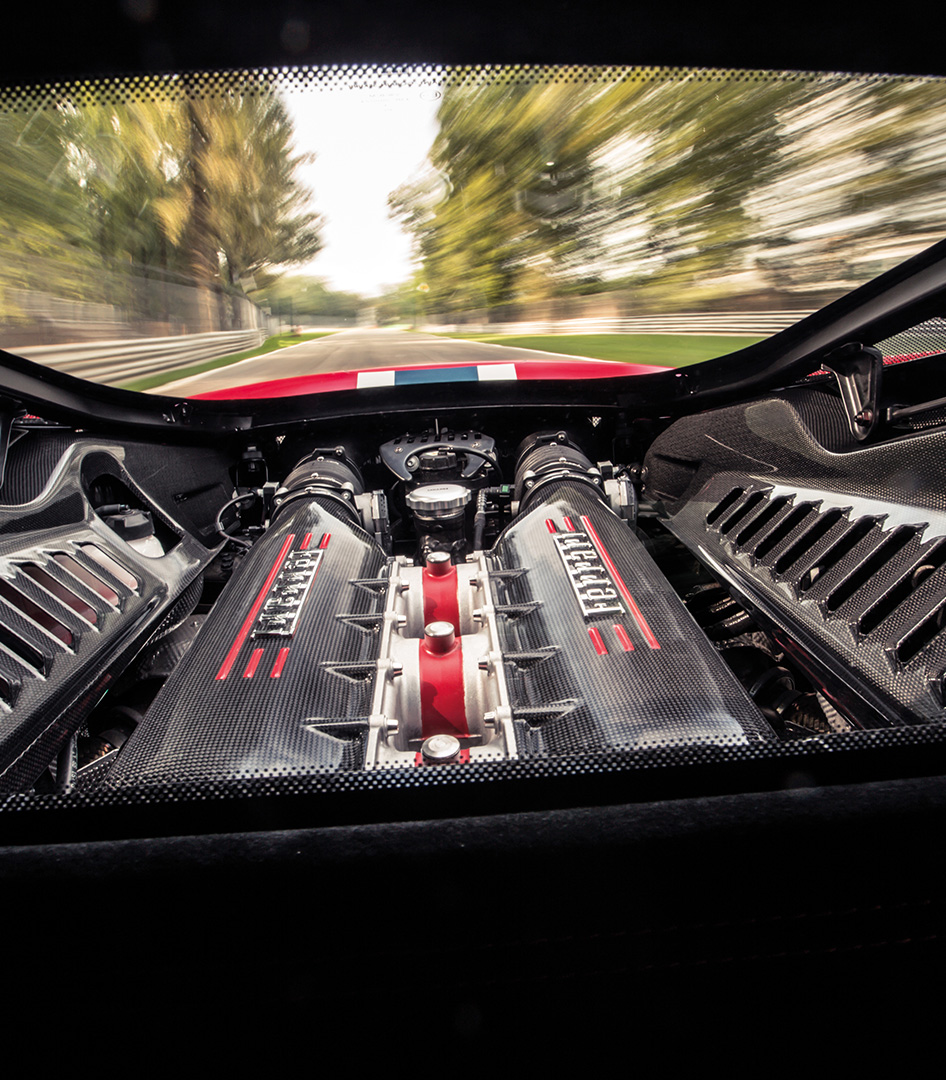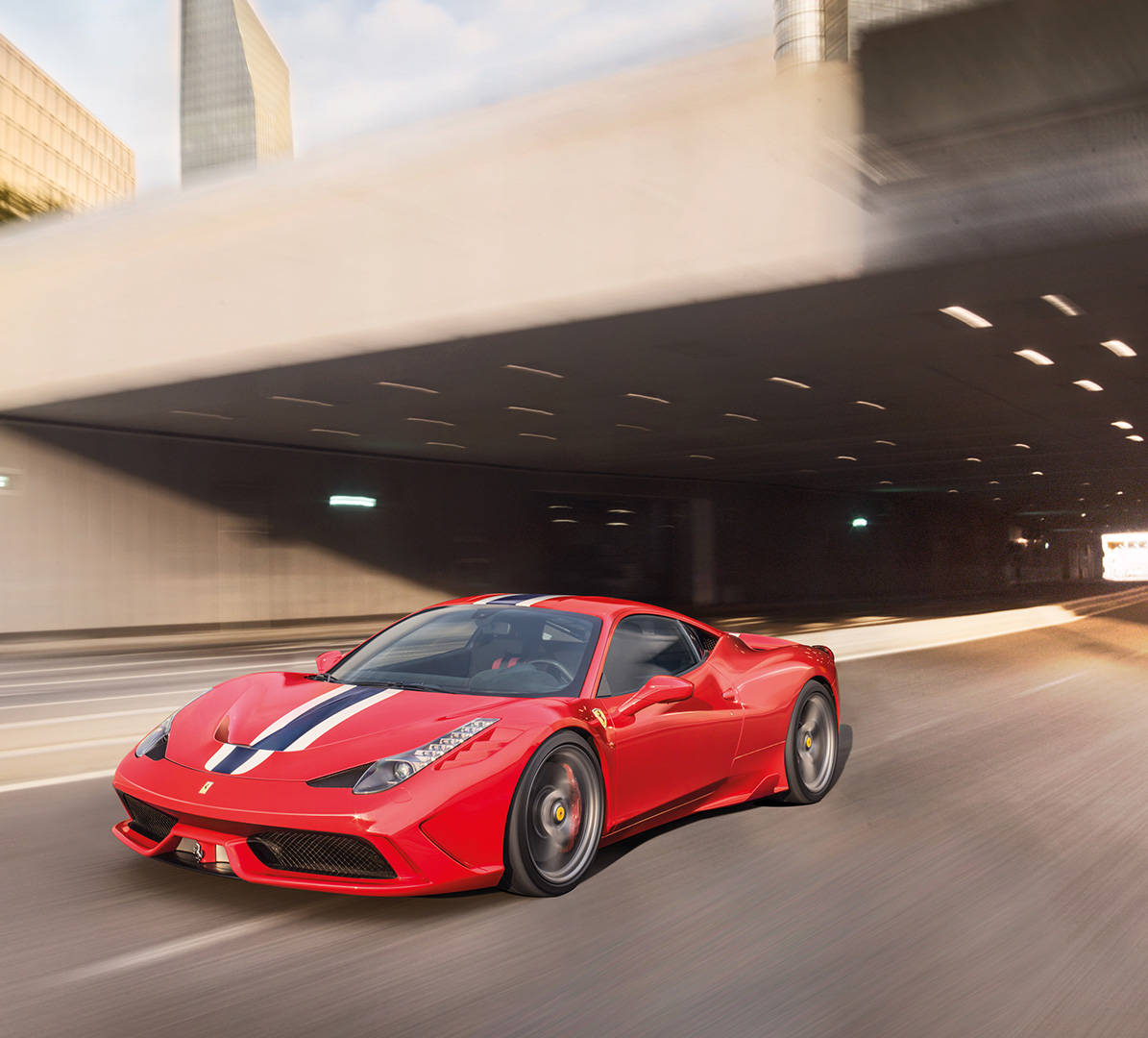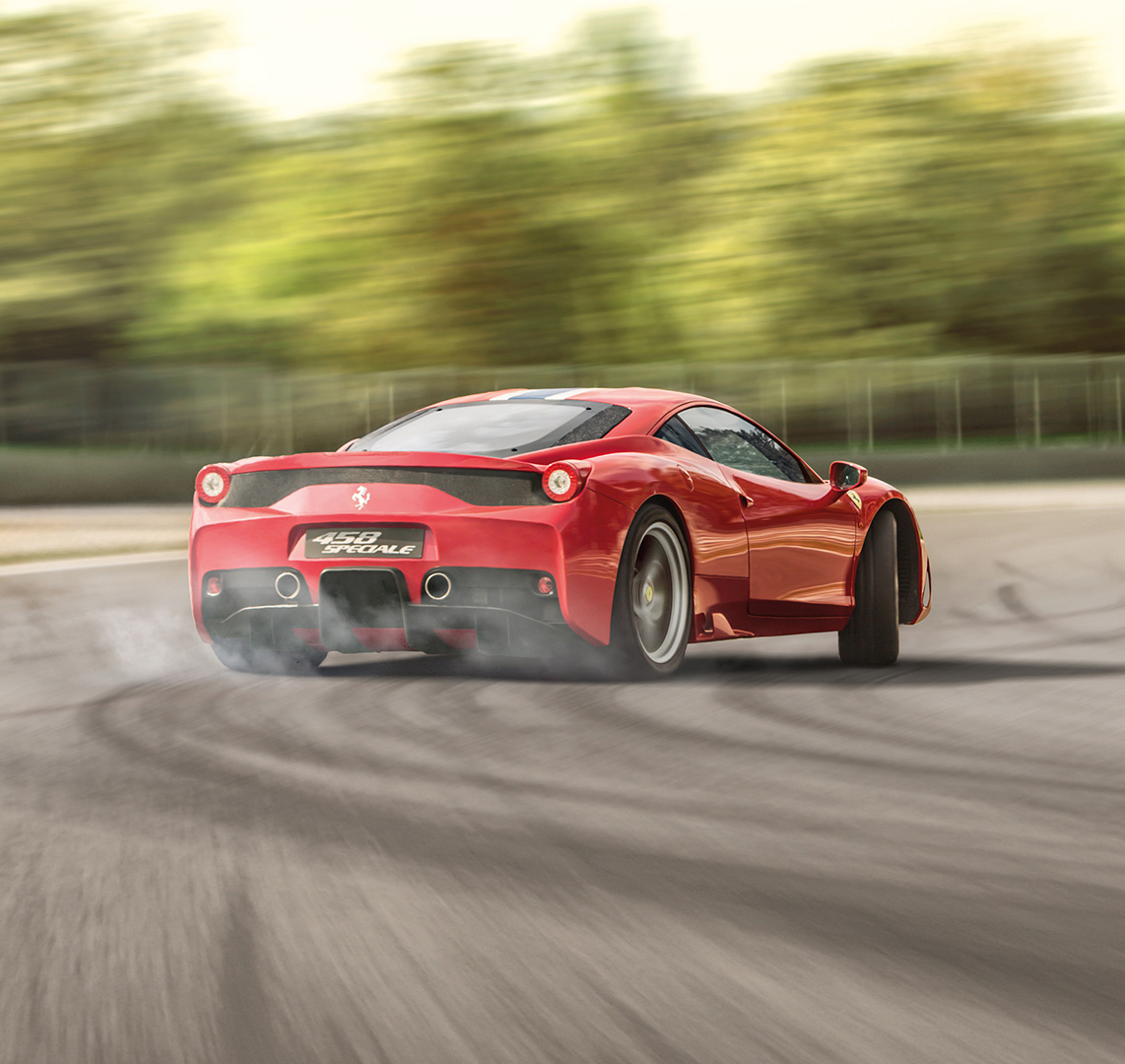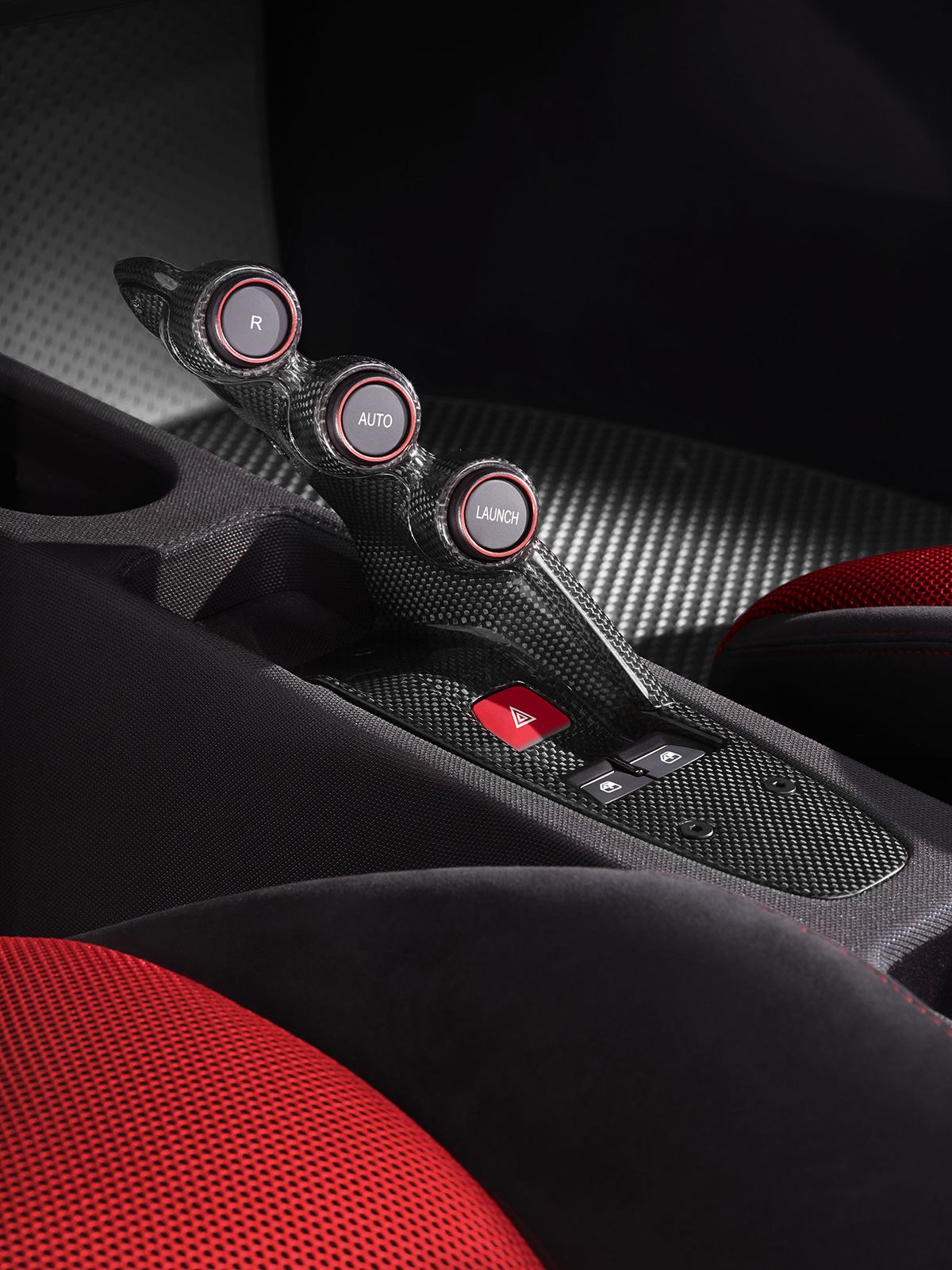Ferrari 458 Speciale
_1200x1600?width=768&height=1024)
EXTREME TECHNOLOGY FOR SPECIAL EMOTIONS
As with all Ferrari special series, the 458 Speciale boasts an array of advanced technical solutions that make it a completely unique model designed for owners looking for an even more focused sports car offering extreme driving emotions.

Unique soundtrack
Two figures sum up just how extraordinary the 458 Speciale’s mid-rear 4.497 cc V8 really is: its ability to punch out 605 cv at 9000 rpm makes it the most powerful naturally aspirated V8 ever built at Maranello while its specific power output of 135 cv/l is a world record for a road-going naturally aspirated engine. Honing of the entire car also resulted in an exceptional weight-power ratio of 2.13 kg/cv and the kind of performance that makes it worthy of the Speciale moniker: 0 to100 km/h acceleration in 3” (9”1 0 to 200 km/h) and a record 1’23”5 lap time at Fiorano.

To achieve these results, Maranello’s engineers maximised the 458’s V8 potential, carrying out detailed refinements to all the components, optimising combustion, volumetric and mechanical efficiency. Ambitious targets set at the design phase included boosting torque across the entire power curve by increasing the compression ratio to 14:1, once again a record for an engine of this layout.
Ferrari drew heavily on its extensive F1 knowledge at the design, process and control stages. The engine is produced in the factory’s in-house foundry using the same processes and machinery employed by the F1 team to deliver complex components with the necessary extreme structural and dimensional characteristics.
Optimised combustion chamber fluid-dynamics, new intake geometries, and a new cam profile are just some of the adjustments that allowed the designers meet their targets. Other significant factors were the revision of various engine components: new materials for the pistons and the con-rod bushings, for example. The crankshaft geometry was also redesigned as was the intake system, the latter cutting engine weight by eight kg.
This very special engine has an equally unique soundtrack that is seductive and uncompromising both inside and outside the car, thanks to the position of the tailpipes, the silencer configuration and a redesigned inlet tract.


extraordinary efficiency
The 458 Speciale’s extraordinary aerodynamic efficiency is the fruit of a string of innovative and original advances that yielded an excellent downforce (Cl) value of 0.53 whilst still keeping the drag coefficient (Cd) at a very low 0.35.
The car’s active aerodynamics – a new Ferrari patent - played a fundamental part in the creation of the 458 Speciale and allow it adopt different configurations to deliver maximum downforce in cornering and minimum drag on straights.

At the front of the car are two vertical flaps in the centre with a horizontal flap below them.
At relatively low speeds, the frontal flaps are closed, channelling air into the radiators to guarantee the necessary cooling for the engine. However, at speeds in excess of 170 km/h, the flaps open, reducing the volume of air flowing into the radiators, thereby cutting drag. At speeds of over 220km/h the horizontal flap lowers to balance downforce between the front and rear axles, leading to a 20 per cent shift in overall downforce towards the rear.
Part of the increase in downforce as well as the 4 per cent shift of the aerodynamic balance towards the front is as a result of the turning vanes at either side of the front bumper and also the aerodynamic fins. The front dam and the hump at the start of the flat underbody reduce pressure at the front of the car too. A larger, more exaggerated spoiler has improved rear downforce (Cl) by 7 points. Moving the position of the tailpipes also allowed a new diffuser to be designed too. Its extraction capacity is optimised, improving downforce over the whole of the underbody. Aerodynamics is further boosted by the active rear flaps which raise and lower as required (more downforce, less drag): electronically controlled, they can be lowered by as much as a 17° angle which stalls the diffuser and reduces Cd by 3 points.


A STEERING RESPONSE TIME of 0.060 seconds
Electronics, brakes, suspensions, tyres: all feature new technological innovations that deliver genuinely superb performances worthy of the Speciale moniker. These not only improve the 458 Speciale’s time over single laps, but also the repeatability of that performance on subsequent laps without needing to be a professional driver, offering unprecedented exhilaration. A steering response time of 0.060 seconds and lateral acceleration of 1.33 g are the highest ever achieved for a Ferrari production car, guaranteeing the 458 Speciale will satisfy even our most performance-oriented owners.

SIDE SLIP ANGLE CONTROL (SSC)
In terms of electronic management, the 458 Speciale marks the world debut of Side Slip Angle Control (SSC) and an upgrade of the F1 transmission control logic.
Thanks to a sophisticated new algorithm, SSC instantaneously calculates the car’s side slip angle, comparing it with reference data: torque management is optimised while differential torque is distributed more efficiently. With the Manettino set at RACE or CT OFF, the 458 Speciale then makes the most of available grip for improved acceleration out of corners, greater ease and control on the limit, and more consistent performance.
GEAR-SHIFT STRATEGY
The 458 Speciale’s F1 dual clutch transmission delivers an even keener sense of urgency too. Response times are more prompt than ever with 40 per cent faster longitudinal acceleration and engine revs adapting 20 per cent more rapidly in up-shifts, while the transient time required for engine revs to match the gear ratio in down-shifts is 44 per cent faster.
Every component of the Brembo braking system has been evolved from the solutions introduced on the LaFerrari. New Extreme Design calipers, HT2 discs with a higher percentage of silicon, and smaller front HY material pads result in eight per cent shorter stopping distances than the 458 Italia and more consistent performance under severe use.

FREQUENCY-SHAPED SCM-E
The 458 Speciale is satisfying and easy to drive on the limit in faster, sharper, more challenging changes of direction too, thanks to incredibly fast response times combined with more precise body control. Also fundamental to this are its Frequency-Shaped SCM-E (Frs SCM-E) dampers, which have twin solenoids, a new CPU and new software that modifies the magnetic field every millisecond.
TYRES AND WHEELS
Ferrari’s partnership with Michelin led to the development of tyres conceived specifically for this car. Offering 6 per cent more grip, the new Michelin Pilot Sport Cup2 tyres feature a compound obtained using specific additives to boost performance over single laps in the dry, consistency over multiple laps and grip in the wet. The 20 inch specially designed forged wheels are also 12 kg lighter than the 458 Italia’s.


EXTREME RACING-INSPIRED STYLE
Producing compact, sculpted performance-honed forms. This was the first priority in the work carried out by the Ferrari Style Centre which collaborated on the project with Pininfarina.

Most of the bodywork panels have been redesigned without modifying either the passenger cell or the signature design features of the 458 Italia. The thickness of the glass used has been reduced to cut weight, while the rear windscreen is now a Lexan© panel.
The composite bumpers have been redesigned and the front bonnet now features two deep air outlets to channel away the air exiting the radiator.
The air outlets to the side of the headlight assemblies now also include three louvers reminiscent of past Ferraris such as the 250 GTO and the F40. The rear features a Kamm tail with a full-width grille between the tail-lights and twin exhausts.
The 458 Speciale is being unveiled in an unusual red livery featuring a blue and white central stripe inspired by the historic NART (North America Racing Team) livery. Its five-spoke wheels are available in three colours: gold, dark grey and black.


Racing atmosphere
The cockpit has a distinctly racing-inspired atmosphere. Lightweight exclusive materials, such as Alcantara and carbon-fibre, dominate, yet it still exudes the sense of craftsmanship and sophistication typical of all Ferrari interiors, thanks to hand-stitching, aluminium tread plates and fluidly sculpted door panels. The styling retains the same aesthetic language as the 458 Italia, playing on the overlapping of materials and forms to visually break up the volumes and underscore the comfort of the interior.
The glove compartment on the dash has been replaced with convenient odds and ends pockets on the tunnel and doors, significantly streamlining the volumes in that area. The cockpit’s ergonomic layout is boosted too by the now-iconic bridge, a carbon-fibre wing that extends over the central tunnel section, putting the F1 gearbox controls at an ideal angle to the driver.
The Sabelt seats have carbon-fibre shells, ergonomic side bolstering and, thanks to Alcantara-trimmed shoulder-rests, excellent grip. The backrests and seats are padded with a breathable 3D fabric for superb air circulation and comfort.

- V8ENGINE
- 4497 ccTOTAL DISPLACEMENT
- 605 CVMAXIMUM POWER @ 9000 rpm
- >325 km/hTOP SPEED
- TypeV8 - 90°
- Bore and stroke 94 x 81 mm (3.7 x 3.2 in)
- Overall displacement 4497 cc
- Compression ratio 14:1
- Maximum power** 445 kW (605 cv) at 9000 rpm
- Specific power output 135 cv/l
- Maximum torque 540 Nm at 6000 rpm
- Maximum revs (limiter) 9000 rpm
- Length 4571 mm
- Width 1951 mm
- Height 1203 mm
- Wheelbase 2650 mm
- Front track 1679 mm
- Rear track 1632 mm
- Dry weight* 1290 kg
- Kerb weight* 1395 kg
- Weight distribution 42% front, 58% rear
- Weight/power ratio 2.13 kg/cv
- Fuel tank capacity 86 l
- Front245/35 ZR20 J9.0
- Rear305/30 ZR 20 J11.0
- Front398x223x36 mm
- Rear360x233x32 mm
- ESC, High performance ABS/EBD, F1-Trac, E-diff, SCC, Frd SCM-E
- 7-speed F1 dual-clutch transmission
- Maximum speed >325 km/h
- 0-100 km/h 3.0 sec
- 0-200 km/h 9.1 sec
- 0-400 m 10.7 sec
- 0-1000 m 19.4 sec
- Weight/power ratio 2.13 kg/cv
- Fiorano lap time 1'23''5
- Fuel consumption 11.8 l/100 km
- CO2 emissions 275 gr/km
- *With optional equipment
- **Including 3.7 kW by ram effect
- Engine
- Aerodynamics
- Dynamics
- Design
- Interior
- Technical details
- Media gallery
